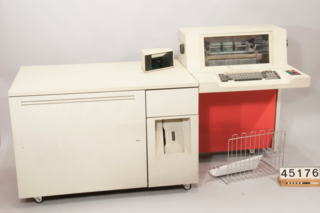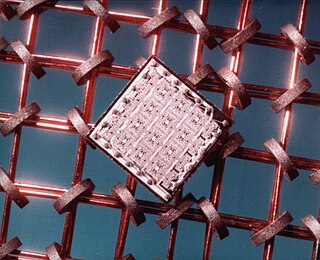Related Research Articles
The control unit (CU) is a component of a computer's central processing unit (CPU) that directs the operation of the processor. A CU typically uses a binary decoder to convert coded instructions into timing and control signals that direct the operation of the other units.
A complex instruction set computer is a computer architecture in which single instructions can execute several low-level operations or are capable of multi-step operations or addressing modes within single instructions. The term was retroactively coined in contrast to reduced instruction set computer (RISC) and has therefore become something of an umbrella term for everything that is not RISC, where the typical differentiating characteristic is that most RISC designs use uniform instruction length for almost all instructions, and employ strictly separate load and store instructions.
In processor design, microcode serves as an intermediary layer situated between the central processing unit (CPU) hardware and the programmer-visible instruction set architecture of a computer, also known as its machine code. It consists of a set of hardware-level instructions that implement the higher-level machine code instructions or control internal finite-state machine sequencing in many digital processing components. While microcode is utilized in general-purpose CPUs in contemporary desktops, it also functions as a fallback path for scenarios that the faster hardwired control unit is unable to manage.
A microassembler is a computer program that helps prepare a microprogram, called firmware, to control the low level operation of a computer in much the same way an assembler helps prepare higher level code for a processor. The difference is that the microprogram is usually only developed by the processor manufacturer and works intimately with the computer hardware. On a microprogrammed computer the microprogram implements the operations of the instruction set in which any normal program is written. The use of a microprogram allows the manufacturer to fix certain mistakes, including working around hardware design errors, without modifying the hardware. Another means of employing microassembler-generated microprograms is in allowing the same hardware to run different instruction sets. After it is assembled, the microprogram is then loaded to a control store to become part of the logic of a CPU's control unit.

In computer programming, machine code is computer code consisting of machine language instructions, which are used to control a computer's central processing unit (CPU). Although decimal computers were once common, the contemporary marketplace is dominated by binary computers; for those computers, machine code is "the binary representation of a computer program which is actually read and interpreted by the computer. A program in machine code consists of a sequence of machine instructions ."

The IBM System/360 (S/360) is a family of mainframe computer systems that was announced by IBM on April 7, 1964, and delivered between 1965 and 1978. It was the first family of computers designed to cover both commercial and scientific applications and a complete range of applications from small to large. The design distinguished between architecture and implementation, allowing IBM to release a suite of compatible designs at different prices. All but the only partially compatible Model 44 and the most expensive systems use microcode to implement the instruction set, featuring 8-bit byte addressing and binary, decimal and hexadecimal floating-point calculations.

In computing, booting is the process of starting a computer as initiated via hardware such as a button or by a software command. After it is switched on, a computer's central processing unit (CPU) has no software in its main memory, so some process must load software into memory before it can be executed. This may be done by hardware or firmware in the CPU, or by a separate processor in the computer system.
In computer architecture, 8-bit integers or other data units are those that are 8 bits wide. Also, 8-bit central processing unit (CPU) and arithmetic logic unit (ALU) architectures are those that are based on registers or data buses of that size. Memory addresses for 8-bit CPUs are generally larger than 8-bit, usually 16-bit. 8-bit microcomputers are microcomputers that use 8-bit microprocessors.
In computer science, an instruction set architecture (ISA) is an abstract model of a computer. A device that executes instructions described by that ISA, such as a central processing unit (CPU), is called an implementation.
In computer architecture and engineering, a sequencer or microsequencer generates the addresses used to step through the microprogram of a control store. It is used as a part of the control unit of a CPU or as a stand-alone generator for address ranges.
A processor register is a quickly accessible location available to a computer's processor. Registers usually consist of a small amount of fast storage, although some registers have specific hardware functions, and may be read-only or write-only. In computer architecture, registers are typically addressed by mechanisms other than main memory, but may in some cases be assigned a memory address e.g. DEC PDP-10, ICT 1900.

The IBM System/32 introduced in January 1975 was a midrange computer with built-in display screen, disk drives, printer, and database report software. It was used primarily by small to midsize businesses for accounting applications. RPG II was the primary programming language for the machine.

In computer central processing units, micro-operations are detailed low-level instructions used in some designs to implement complex machine instructions.
A control register is a processor register that changes or controls the general behavior of a CPU or other digital device. Common tasks performed by control registers include interrupt control, switching the addressing mode, paging control, and coprocessor control.

The history of general-purpose CPUs is a continuation of the earlier history of computing hardware.

Read-only memory (ROM) is a type of non-volatile memory used in computers and other electronic devices. Data stored in ROM cannot be electronically modified after the manufacture of the memory device. Read-only memory is useful for storing software that is rarely changed during the life of the system, also known as firmware. Software applications for programmable devices can be distributed as plug-in cartridges containing ROM.

Random-access memory is a form of electronic computer memory that can be read and changed in any order, typically used to store working data and machine code. A random-access memory device allows data items to be read or written in almost the same amount of time irrespective of the physical location of data inside the memory, in contrast with other direct-access data storage media, where the time required to read and write data items varies significantly depending on their physical locations on the recording medium, due to mechanical limitations such as media rotation speeds and arm movement.

The IBM System/370 Model 165 were jointly announced June 30, 1970 as "designed for ... the Seventies." That same day IBM announced the 370/195. They were the first three models of the IBM System/370 line of computers.

The IBM System/370 Model 135 was announced March 8, 1971, the only 370 introduced that year. The 135 was IBM's fifth System 370, and it was withdrawn October 16, 1979.
Intel microcode is microcode that runs inside x86 processors made by Intel. Since the P6 microarchitecture introduced in the mid-1990s, the microcode programs can be patched by the operating system or BIOS firmware to work around bugs found in the CPU after release. Intel had originally designed microcode updates for processor debugging under its design for testing (DFT) initiative.
References
- ↑ Koopman Jr., Philip (1987). "Writable instruction set, stack oriented computers: The WISC Concept" (PDF). The Journal of Forth Application and Research. 5 (1): 49–71.
- ↑ Koopman Jr., Philip (1989). "Architecture of the WISC CPU/16". Stack Computers: the new wave.
- ↑ Koopman Jr., Philip (1989). "Architecture of the RTX 32P". Stack Computers: the new wave.
- ↑ IBM (September 1974), IBM System/370 Principles of Operation (PDF), Fourth Edition, pp. 98, 245, GA22-7000-4
- ↑ IBM (June 1968), IBM System/360 Model 85 Functional Characteristics (PDF), SECOND EDITION, A22-6916-1
- ↑ IBM (March 1969), IBM System/360 Special Feature Description 709/7090/7094 Compatibility Feature for IBM System/360 Model 85, First Edition, GA27-2733-0
- ↑ IBM (January 1971), IBM System/370 Model 155 Functional Characteristics (PDF), SECOND EDITION, GA22-6942-1
- ↑ Smith, Eric (September 3, 2002). "Re: What was the size of Microcode in various machines". Newsgroup: comp.arch.
- ↑ Mark Smotherman. "CPSC 330 / The Soul of a New Machine".
4096 x 75-bit SRAM writeable control store: 74-bit microinstruction with 1 parity bit (18 fields)
- ↑ McDowell, Charlie (1982). "Protection at the micromachine level". ACM SIGARCH Computer Architecture News. 10 (1): 5. doi:10.1145/859520.859521 . Retrieved 2023-11-25.
It is not unusual to find microprograms that are greater than 50K bytes in size. This increase in size, and the expansion of microprograming beyond the traditional bounds of machine instruction emulation, have increased the possibility of both malicious and faulty microprograms, particularly the later.
- ↑ "Great Microprocessors of the Past and Present (V 13.4.0)". Cpushack.com. Retrieved 2010-04-26.
- ↑ Intel 64 and IA-32 Architectures Software Developer's Manual, Volume 3A: System Programming Guide, Part 1 (PDF). December 2009. chapter 9.11: "Microcode update facilities".
- ↑ Stiller, Andreas; Paul, Matthias R. (1996-05-12). "Prozessorgeflüster". c't – magazin für computertechnik . Trends & News / aktuell - Prozessoren (in German). Vol. 1996, no. 6. Verlag Heinz Heise GmbH & Co KG. p. 20. ISSN 0724-8679. Archived from the original on 2017-08-28. Retrieved 2017-08-28.
- ↑ Gwennap, Linley (1997-09-15). "P6 Microcode Can Be Patched - Intel Discloses Details of Download Mechanism for Fixing CPU Bugs" (PDF). Microprocessor Report . MicroDesign Resources. Archived (PDF) from the original on 2022-05-19. Retrieved 2017-06-26. (2 pages)
- ↑ "Intel Microcode Update Utility for Linux". Archived from the original on 2012-02-26.
- ↑ Stefan Blachmann (2018-03-02). "New microcode updating tool for FreeBSD". freebsd-hackers (Mailing list). Retrieved 2019-07-09.
- ↑ "A microcode reliability update is available that improves the reliability of systems that use Intel processors". Microsoft Support. June 22, 2007. Archived from the original on 2007-06-28.
- ↑ "BIOS Update required when Missing Microcode message is seen during POST". Intel . Retrieved 2022-01-13.
- ↑ Don Lancaster. "TV Typewriter Cookbook". p. 62. (TV Typewriter)